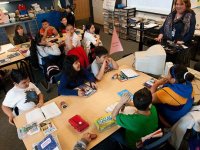English Learners and 21st-Century Literacy
We all know that the demographics of America's public school population are shifting. In 2011, nearly a quarter -- 23.9 percent -- of pre-K-12 students was Hispanic, many either immigrants or the children of immigrants who speak another language at home. And that proportion is projected to grow in the coming years, bringing new challenges and opportunities to schools across the country.
One challenge: better educating students who speak English as a second language. One opportunity: leveraging the strengths that these students offer to improve schools for all. And research by Dr. Mary Amanda "Mandy" Stewart, who recently completed a dissertation that highlights the 21st-century skills and cultural resources of immigrant youth, provides guidance on how to do both.
Where English Learners Demonstrate Literacies
In her dissertation, which won PDK International's 2012-2013 Outstanding Doctoral Dissertation Award, Stewart examined the life and literacy of four 17- to 20-year-old students from Mexico, El Salvador, and Guatemala. In doing so, she uncovered multiple ways in which these students are leveraging their out-of-school competencies to improve their English and develop and demonstrate 21st-century skills:
- Facebook In addition to allowing immigrant students to stay connected with friends and family in their home countries, Facebook helps English learners develop multiliterate skills -- they post in both English and Spanish and use youth codes in both. In fact, Stewart found that these students use more English on Facebook than in school, where they rarely talk in class or to English-speaking peers
- Work While these students are considered at-risk at school, at their jobs they shine. They are developing their English skills in an authentic environment. They are more likely to make English-speaking friends at work than at school. And, importantly, at work their emerging bilingual skills are valued -- and used -- in a way that they are not in the school setting
- Entertainment These students all enjoy some form of Spanish entertainment, which both reminds them of their home countries and allows them to express their Latino and transnational identities
Unfortunately, these competencies are not crossing into school lives -- not necessarily surprising considering that, as Stewart points out, "the tests they must pass to graduate are monolingual, monoliterate, monocultural, and monomodal. Unfortunately so are most of their assignments, curriculum, and instruction." But one overall finding was particularly striking:
Classroom Implications
These findings have a number of implications for educators. Stewart's advice:
- Provide literature that is culturally relevant, age appropriate, and accessible to ELs at their current level of English acquisition
- Use online writing to help students develop relationships and practice English with other students. Make it part of a language and cultural exchange where English-speaking students -- who often take foreign language classes -- also practice the first language of the ESL student
- Allow students to research topics of interest. If students are truly interested in a topic, they will probably learn more language
- Provide a space where all languages have equal power. Have students work together to complete a service-learning task, interview each other, or work on a project using both languages
- Take advantage of professional learning opportunities specifically to benefit English learners. For example, join a professional organization such as TESOL or the National Association for Bilingual Education (NABE)
- Get to know students as human beings. Honor the resources they bring to the classroom and recognize their multiple literacies
Broader Implications
Stewart's findings also have a number of policy implications. She recommends investing in the development of a students' first language alongside English. She also suggests that all states adopt the Seal of Biliteracy for high school diplomas to demonstrate the value of developing multiple languages -- not just for ELs, but for all students.
There are implications for accountability policy as well. As a classroom teacher, Stewart saw how the linguistic and cultural resources that her students brought into the classroom were "ignored, devalued, and underutilized" in many schools as the pressures of improving standardized test scores led to a one-size-fits-all model of curriculum and instruction that does not ensure authentic learning opportunities.
Ultimately, it is important to remember that many ELs are willing to do whatever it takes to succeed. But it is also important to consider whether our education policies reflect what we as a society value. As Stewart says:
